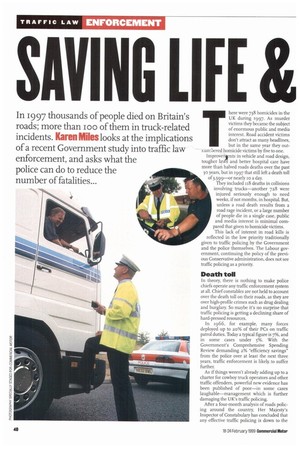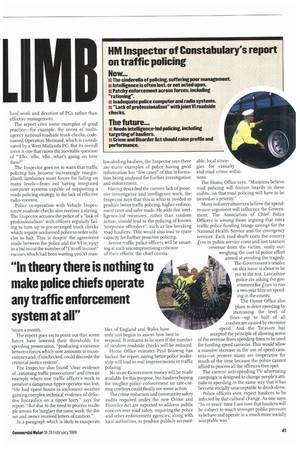SAVING LIFE
Page 42

Page 43

If you've noticed an error in this article please click here to report it so we can fix it.
In 1997 thousands of people died on Britain's roads; more than ioo of them in truck-related
incidents. Karen Miles looks at the implications of a recent Government study into traffic law enforcement, and asks what the
police can do to reduce the number of fatalities...
There were 738 homicides in the UK during 1997. As murder victims they became the subject of enormous public and media interest. Road accident victims don't attract as many headlines, but in the same year they outranr-.Sered homicide victims by five to one.
Improvenr-nts in vehicle and road design, tougher laA and better hospital care have more than halved roads deaths over the past 30 years, but in 1997 that still left a death toll of 3,599—or nearly ro a day.
They included 118 deaths in collisions involving trucks—another 728 were injured seriously enough to need weeks, if not months, in hospital. But, unless a road death results from a road rage incident, or a large number of people die in a single case, public and media interest is minimal compared that given to homicide victims. This lack of interest in road kills is reflected in the low priority traditionally given to traffic policing by the Government and the police themselves. The Labour government, continuing the policy of the previous Conservative administration, does not see traffic policing as a priority.
Death toll
In theory, there is nothing to make police chiefs operate any traffic enforcement system at all. Chief constables are not held to account over the death toll on their roads, as they are over high-profile crimes such as drug dealing and burglary. So maybe it's no surprise that traffic policing is getting a declining share of hard-pressed resources.
In 1966, for example, many forces deployed up to 20% of their PCs on traffic patrol duties. Today a typical figure is 7%, and in some cases under 5%. With the Government's Comprehensive Spending Review demanding 2% "efficiency savings" from the police over at least the next three years, traffic enforcement is likely to suffer further.
As if things weren't already adding up to a charter for cowboy truck operators and other traffic offenders, powerful new evidence has been published of poor—in some cases laughable—management which is further damaging the UK's traffic policing.
After a four-month analysis of roads policing around the country, Her Majesty's Inspector of Constabulary has concluded that any effective traffic policing is down to the hard work and devotion of PCs rather than effective management.
The report cites some examples of good practice—for example, the series of multiagency national roadside truck checks, codenamed Operation Mermaid, which is co-ordinated by a West Midlands PC. But its overall tenor is one that raises the inevitable question of "'Ello, 'ello, 'ello...what's going on here then?"
The Inspector goes on to warn that traffic policing has become increasingly marginalised, lambastes most forces for failing on many levels—from not having integrated computer systems capable of supporting a roads policing strategy, to the lack of effective radio systems.
Police co-operation with Vehicle Inspectorate roadside checks also receives a slating. The Inspector accuses the police of a "lack of professionalism" with officers regularly failing to turn up to pre-arranged truck checks which require uniformed police to order vehicles to halt. This is despite the agreement made between the police and the VI in 199') in a bid to cut the number of "I'm off to court" excuses which had been wasting 300 VI man hours a month.
The report goes on to point out that some forces have lowered their thresholds for speeding prosecution, "producing a variance between forces which now amounts to inconsistency and, if unchecked, could discredit the criminal justice system".
The Inspector also found "clear evidence of...rationing traffic prosecutions" and cites an example where one traffic officer's work to penalise a dangerous tipper operator was lost. "He had spent hours in inclement weather gaining complex technical evidence of defective hydraulics on a tipper lorry," says the report. "But due to the need to process multiple arrests for burglary the same week, the driver and owner received letters of caution."
In a paragraph which is likely to exasperate law-abiding hauliers, the Inspector says there are many examples of police having good information but "few cases" of that information being analysed for further investigation and enforcement.
Having described the current lack of proactive investigative and intelligence work, the Inspector says that this is what is needed to produce better traffic policing, higher enforcement rates and safer roads. He adds that intelligence-led measures, rather than random action, should lead to the policing of known "corporate offenders", such as law-breaking road hauliers. This would also lead to spare capacity for further proactive policing.
Senior traffic police officers will be smarting at such uncompromising criticism of their efforts: the chief consta bles of England and Wales have only just begun to assess how best to respond. It remains to be seen if the number of random roadside checks will be reduced.
Home Office minister Paul Boateng has backed the report, saying better police leadership will lead to real improvements in traffic policing.
No more Government money will be made available for this purpose, but hauliers hoping for tougher police enforcement on rate-cutting cowboys could finally see some action.
The crime reduction and community safety audits required under the new Crime and Disorder Act are expected to address public concern over road safety, requiring the police and other enforcement agencies, along with local authorities, to produce publicly account
able, local strategies for casualty and road crime reduc tions.
The Home Office says: "Ministers believe road policing will feature heavily in these audits...so that road policing will have to be treated as a priority."
Many industry observers believe the spendto-save argument will influence the Government. The Association of Chief Police Officers is among those arguing that extra traffic police funding brings savings for the National Health Service and the emergency services. Each road death costs the country Dm in public service costs and lost taxation revenue from the victim, vastly outweighing the cost of police effort aimed at avoiding the tragedy. The Government's resolve on this issue is about to be put to the test. Lancashire police are asking the gov ernment for fism to run a two-year blitz on speed ing in the county.
The Home Office also plans to deter speeding by increasing the level of fines—up to half of all crashes are caused by excessive speed. And the Treasury has accepted the principle of allowing some of the revenue from speeding fines to be used for funding speed cameras. This would allow a massive increase in the use of speed cameras—at present many are inoperative for much of the time because the police cannot afford to process all the offences they spot.
The current anti-speeding TV advertising campaign is designed to change people's attitude to speeding in the same way that it has become socially unacceptable to drink-drive.
Police officers even expect hauliers to be infected by that cultural change. As one says: "In to years' time I am sure that hauliers will be subject to much stronger public pressure to behave and operate in a much more socially acceptable way."
















































































































